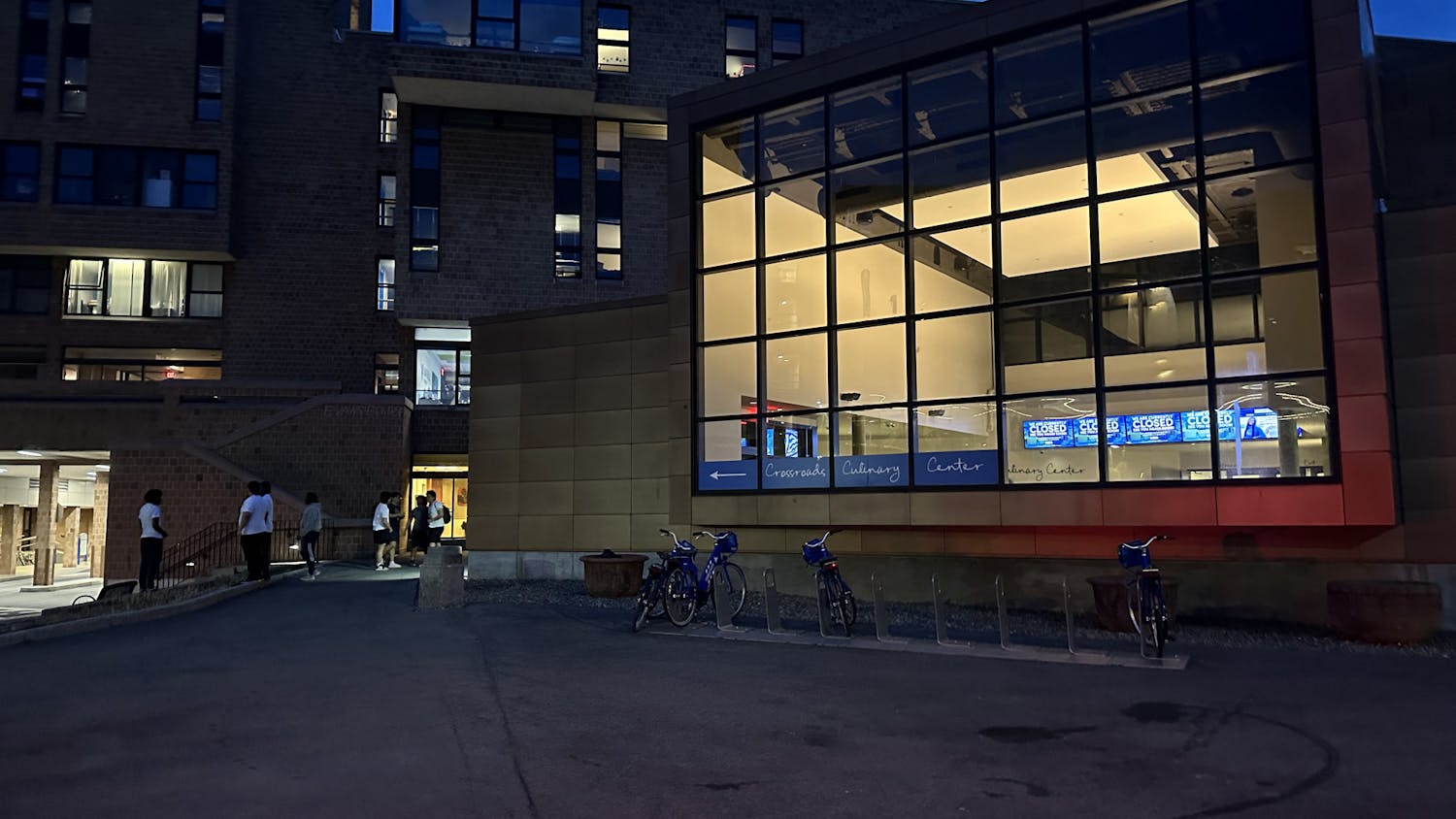We have our answer. Sort of.
In case you missed Wednesday's issue of The Spectrum, let me explain today's front page: It is UB President Satish Tripathi's response to the students who are demanding answers about the university's involvement (or the lack thereof) in the University Heights. On Monday, we published Lisa Khoury's article "The Heights of Fear," which outlines problems in the South Campus neighborhood and UB's hands-off management of crime and poor living conditions for students.
When the University of Pennsylvania had a similar issue with crime in its vicinity, the school invested approximately $185.7 million to fix the area. When Ohio State was in a similar situation, the university's president, E. Gordon Gee, successfully pushed for state legislation to safeguard students.
How has UB handled dangerous living conditions in the Heights? By saying things like "we're not in the protection business" and, in response to a student being robbed, "I'm sure there were, on that same day, 200,000 robberies across New York State and 2 million across the country."
Actually, a basic FBI website search reveals fewer than one thousand robberies happened per day across the United States in 2011, but that isn't the point: UB is clearly downplaying students' fears for their safety. Channel 4 News reported on the situation Wednesday evening, and when reporter Lou Raguse asked Vice Provost for International Education Stephen Dunnett if he considers the University Heights a dangerous area, he simply said, "No," without hesitation.
Students want to support UB, so on Wednesday, we asked Tripathi for a response. We published a front-page editorial - "Dear President Tripathi" - asking him for UB's response to the Heights' problems. We promised him our front page and said if he didn't respond, that would be his statement. Today's front page is his response. Interpret it as you will. To me, it sounds like the kind of jargon we've heard all year. It's certainly not a commitment or even a hint to change.
Tripathi clearly did not want to acknowledge The Spectrum in his response. He neither directly addressed us nor answered our pleas. As an independent student newspaper, The Spectrum represents UB students. In not answering us, he is not answering any of you.
Instead, UB published the letter on its own site, buffalo.edu, and stated it was "intended for broad distribution to several important on-campus communication channels," including The Spectrum. His response has baffled us.
We asked a straight question. Why can't we get a straight answer?
The reaction to the front-page challenge has been overwhelming. Some have chastised my decision; others have applauded. In this column, I'll try to debunk each of the primary arguments I've received concerning our reporting on the University Heights.
You're just trying to make UB look bad.
My father has been a professor at UB for over 30 years. I more or less grew up on campus. Nobody wants to see this school succeed more than I do. By calling something out to eventually make it better, are you trying to bring it down? Look at it this way: You're a high school football coach and you have a player with tons of potential. One day, this kid could carry the team; he could even be one of the best athletes in the country. There's a problem, though: He has terrible running form and never pumps his arms while he strides. Almost every other coach agrees with you: His form needs to be fixed.
Do you care more about the kid if you bring light to the issue or if you pretend there's no problem? He will never fulfill his potential if you decide to stay silent.
The Spectrum's reporting was biased and untrue.
First: As I said, I practically grew up at UB. As I detailed in my Monday column, "For UB to go north, it needs to fix South," I lived in the Heights for 17 years and went through numerous robberies. Clearly, I couldn't write "The Heights of Fear." As it says in the Society of Professional Journalists' Code of Ethics: "Avoid conflicts of interest, real or perceived."
Khoury carried out her reporting with complete objectivity; she is not from the Heights area and has no tie to it. She interviewed many sources on each side - administrators, students, community members and police, among others.
She did not make a judgment in her story. She did not say, "UB is messing up!" She just explained what she found. If you took the story to make UB look bad, maybe that's because UB really is messing up, but that's your assessment. She laid out the evidence; you make your own verdict.
She also included her interaction with Tripathi: He declined an interview. Twice. It's impossible to tell UB's side when administrators will not speak.
Point two: Which part of "The Heights of Fear" is untrue? The answer: It's 100 percent accurate. Khoury spent five months working on the story and every facet has been fact-checked meticulously. Admittedly, we don't always have that long to work on a story, so we make mistakes from time to time, but this article is accurate.
Under ordinary circumstances, someone from the university will contact us immediately if we make a single error. Administrators have been silent.
Why wouldn't you include information about community activists, such as those in the University Heights Collaborative?
As I said, Khoury interviewed people on every side. She interviewed Mickey Vertino, president of the collaborative. So why wouldn't we include that information? Because it didn't fit the story.
Though she received guidance from many editors, Khoury made the final call on which information to include, and I agree with her decision. In journalism, you must constantly ask the question: What's the story? Above all, it's important to stick to the topic. "The Heights of Fear" pertains to crime and living conditions in the Heights and how UB is involved.
Community organizations are immensely important, of course, but I don't think they fall into the scope of the story. Khoury used Vertino's interview as background information, though she did not quote him or write about the collaborative. It is also important to know this isn't a one-article topic. The Spectrum will eventually use that interview with Vertino. The other constant newsroom question is: What's next? We are working on follow-up stories, one of which includes community organizations - which are essential but are not UB-operated. They are doing great things, and we've written about them before, but students are still afraid.
Why wouldn't you go about this with the Student Association, other student leaders and professors?
This type of movement has been in the works all year. SA affiliates have met with University Police, Buffalo Police and UB administrators since the beginning of the fall. All sides seemed fired up to fix the issues, but nothing is getting done. Someone is stalling.
Which side would want to stall? The administrators aren't going anywhere. Students graduate, and the SA higher-ups are almost all graduating this spring. Additionally, we at The Spectrum cannot control anyone outside of ourselves. We can only control what we do.
You're fear-mongering and sensationalizing.
The article factually depicts what students have experienced. Nothing is exaggerated. Have you considered that maybe the topic itself is just scary? Maybe the real story - students being stabbed, having nightmares and being robbed at gunpoint - is sensational. We have not altered any of the stories. We have simply told them.
The students who spoke to you are just "scaredy cats" who need to toughen up.
Have you ever had someone load a rifle and point it at your forehead while stroking the trigger? Have you ever lived every day in a home reeking of hardened raw sewage or slept every night in a room riddled with bed bugs?
You won't get robbed if you're smart.
One student actually had the nerve to say any student who gets robbed is just "retarded" because he has lived on Highgate Avenue his whole life and hasn't had any problems. He then said: "Bunch of dumbasses walking alone at night deserve to be robbed and stabbed."
Two things: 1. Highgate is nowhere near as bad as other parts of the Heights, such as Lisbon and Minnesota. 2. Anyone making this point: Have you ever considered that maybe you're just lucky? In 2008, my doors and windows were locked all hours of every day. I never went out after dark. That didn't stop my University Heights home from being broken into six times or a man from pulling a gun on me in my driveway. What did I do wrong?
In summary...
I know I didn't address every talking point, but there is only so much room in the newspaper. These discussions are essential and, aside from the comments including complete idiocy and name-calling, I respect each point of view and thank you for taking the time to read and respond to "The Heights of Fear."
What's important is that we're talking about the area surrounding South Campus. I don't think anyone honestly thinks the University Heights is a good area. We may disagree in our ideas, but I believe most of us can agree that something needs to change.
I hope this column has helped clarify the choices we made and why we made them. When you're in charge of an organization and people you care about - in this case, the university community - have a problem, you address it directly and vehemently. That's how it usually works.
Usually.
Email: aaron.mansfield@ubspectrum.com





